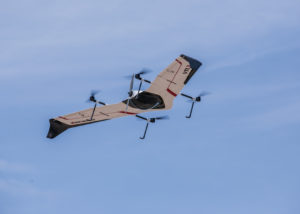
Africa is leading the way on widescale drone delivery: commercial drone applications for mining and other heavy industry are on the rise. African drone regulations are developing rapidly to support the continent’s growing drone industry.
Big Things on the Big Continent – African Drones
By: Dawn M.K. Zoldi, Contributor
Drone deliveries in Africa have made headlines and saved lives. Zipline, with apparent ease, has flown its drones almost one million miles to transport almost 800,000 medical supplies and products including blood, vaccines and medications in both Ghana and Rwanda. How easy is it to operate in Africa? Three trailblazing experts explain the state of regulations in Africa and project what we may see in the future of drone regulations there. It’s not as simple as one might think.
Denise Soesilo, a Women and Drones Woman to Watch 2020 leadership award recipient, has been working with the African Drone Forum (ADF), a multi-stakeholder engagement platform for drone technologies and services that connects the African drone community, curates knowledge relevant to stakeholders, and defines high-frequency drone services’ requirements with the potential for significant social and economic benefits. She explains, “Africa, as a continent, has a heterogeneous regulatory environment which continues to evolve rapidly.” Soesilo and her colleagues have closely studied African drone regulations. “Approximately 33% of African countries (18) have drone regulations in place, 25% have guidance and the remainder lack drone regulations altogether,” she says.
Those regulations vary widely, from state to state. Sonet Kock, Aviation Compliance Advisor at AviComply Ltd, a woman-owned South-African-based professional compliance services company for both manned and unmanned aviation operators, advises that, unlike Europe, Canada, Australia and the United States (U.S.), no pan-African aviation regulatory body or overarching regulatory framework currently exists. The African Union (AU) has met and held talks, but thus far, every state regulates drones for itself. Understanding the regulatory environment, or lack thereof, is critical before operating in Africa.
One nation, South Africa (SA), has been leading the way for African drone regulations. South Africa was the first African country to promulgate drone regulations in 2015. Kim James, Director and Founder of two South African companies, UAV Aerial Works, which employs drone pilots, engineers, software developers and data scientists to provide regulated aerial services and deliver data outputs to improve businesses and Drone Guards, which deploys pilots, drones and software systems in support of security operators worldwide, elaborates on the SA regulatory approach. James informs, “South Africa currently follows the Certification model similar to how the SA Civil Aviation Authority (SACAA) regulates manned aircraft.”
Part 101 of the SA Civil Aviation Regulations (SACARs) governs commercial drone operations meaning those that involve gain, interest or profit. Those requirements include that all operators have an Air Service License (ASL) issued by the Air Service Licensing Council under the Department of Transport, in addition to a Remote Pilots License (RPL) and a Remotely Piloted Aircraft System (RPAS) Operators Certificate (ROC) issued by the SACAA. Each drone must be registered individually and placed on an ROC Operational Specification (OpSpec), which accompanies the ROC and outlines which drones will be flown for what types of operations. Those operations can include beyond visual line of sight (BVLOS), night operations and operations over people (OOP) and higher than 400ft AGL under certain conditions. Permissible OOP flights over people, property and public roads require additional approvals in some instances. Additionally, per James, one needs landowner consent to fly over private and municipal property, for both safety and privacy reasons. ROC approvals are valid for one year.
The SACAA audits drone service providers annually. If a company meets compliance standards, its ROC will be renewed for another year. Each drone must be insured for third party liability. SA does not have a remote identification requirement or counter-drone rules on the books yet. James believes these will be important, once SA and other African countries move toward a cohesive unmanned traffic management (UTM) system. Recreational users can fly their hobby drones within the hobby rules stipulated in Part 101.
Even though SA has no formal UTM system, they have already integrated drones with air traffic control (ATC). According to Kock, in SA, drone pilots communicate by radio directly with ATC.
SA is but one of many examples of drone regulations in Africa. The regulatory environment is as diverse as the physical environment. In many African countries, foreign operators, which include operators from neighboring African countries are unable to legally register their drones if they are not a citizen or national entity. This precludes them from operating there. Some countries, such as Kenya have previously issued outright drone bans. Others, such as Zimbabwe are using South Africa’s regulatory template. James says the news is encouraging. “While some countries are becoming slightly stricter in terms of approvals issued and new registration requirements, many countries are opening up. Last year Kenya lifted its ban on drone flights. Several countries such as Rwanda, and Sierra Leone have been working on adopting elements of the ICAO model on UAS regulations.
“Regional pathways to harmonization is an opportunity in Africa that could support interoperability and also the exchange and trade in services, services providers between countries,” Soesilo, who was also the Director of Flight at the 2020 African Drone Forum (ADF) Lake Kivu Flying Competitions in Rwanda. Soesilo and her ADF colleagues are getting ready to publish a number of practical resources on African drone regulations including: a report reviewing all 55 AU nations’ drone regulations, a primer on UTM services and a playbook for enabling civilian drone services. The group is also currently working on a roadmap for harmonization of regulations.
All three experts agree that a categorization model, similar to the JARUS SORA air and ground risk-based model, would work well as a pan-African and national-level regulatory model. Europe, Canada and Australia already use it.
 Dawn M.K. Zoldi (Colonel, USAF, Retired) is a licensed attorney with 28 years of combined active duty military and federal civil service to the Department of the Air Force. She is an intIernationally recognized expert on unmanned aircraft system law and policy, a columnist for several magazines,recipient of the Woman to Watch in UAS (Leadership) Award 2019, President and CEO of UAS Colorado and the CEO of P3 Tech Consulting LLC. For more information, visit her website at: https://www.p3techconsulting.com.
Dawn M.K. Zoldi (Colonel, USAF, Retired) is a licensed attorney with 28 years of combined active duty military and federal civil service to the Department of the Air Force. She is an intIernationally recognized expert on unmanned aircraft system law and policy, a columnist for several magazines,recipient of the Woman to Watch in UAS (Leadership) Award 2019, President and CEO of UAS Colorado and the CEO of P3 Tech Consulting LLC. For more information, visit her website at: https://www.p3techconsulting.com.






[…] regulatory environment for drone operations. Nonetheless, more work is needed for flexible and harmonised regulations across countries and sectors. For example, Rwanda has adopted performance-based regulations for […]